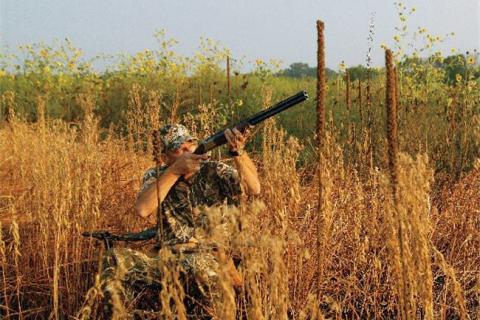
Doves frustrate the most experienced wingshots. They're fast. They're small. They're hard to hit. If you can down one bird for every three shots fired, you've earned a nickname like "Deadeye" or "Killer."
 My best friend, Lewis "Deadeye" Peeler, consistently bags more doves than any hunter I know.I've seen him shoot 10 flying doves with 10 shells on more than one occasion."He rarely misses," one acquaintance said enviously. "But hunt rabbits with him and he's liable to shoot a whole box of shells to get three or four cottontails."
My best friend, Lewis "Deadeye" Peeler, consistently bags more doves than any hunter I know.I've seen him shoot 10 flying doves with 10 shells on more than one occasion."He rarely misses," one acquaintance said enviously. "But hunt rabbits with him and he's liable to shoot a whole box of shells to get three or four cottontails."
That's because as a dove shooter, Lewis is no expert, but as a successful dove hunter, he's the cream of the crop. He has an uncanny ability to appraise a feeding field and pinpoint the one spot most doves entering and leaving the field are sure to pass. He knows where they'll slow down. And he picks a stand that provides the kind of shots he's best at.
![]() Tip: Dove Hunting Basics: Tips to Get You Started
Tip: Dove Hunting Basics: Tips to Get You Started
Not the Best Marksman
 |
| Get set up so you can intercept doves in a way that gives you the best shots. |
"You don't have to be the best marksman in the field to kill the most doves with the fewest shots," he once said. "The secret is knowing how to pick a stand that gives you advantages." This is where Lewis excels.
Doves aren't like quail, woodcock or other upland birds that hunters walk up or hunt with dogs. Doves are hunted from a stand. They come to the hunter, or don't, depending on how astutely he's chosen his position. The more doves that fly within range, the more shooting opportunities the hunter will have. The slower they're moving, the easier the shots will be. And the more shot angles the hunter gets that suit his skill, the better he will do.
The best example of this I can recall involved Deadeye Peeler himself and illustrates how good dove shooting can be arranged by someone who understands the dynamics of selecting a stand. It happened in a cutover milo field bordered on three sides by bands of trees and on the fourth side by a small river. Four hunters and I made beelines to the field edges. Lewis lagged behind. "I'll be along in a few minutes," he said.
Numerous doves flew into the field, from all directions it seemed. Occasionally one passed by close enough for a shot, but for the most part, they blazed by out of range before dropping to the ground. We weren't doing much shooting.
Lewis stood and watched for 30 minutes or so, then walked the length of the field and disappeared into the edge of the timber. Almost immediately, I heard a gunshot from his direction, followed shortly by another and another and another. Every five minutes or so during the next hour, I heard him shoot. Then I saw him heading my way.
"Why are you moving?" I asked as he approached. "From the sounds of the shooting, I figured you must have been in a pretty good spot."
"I was," he answered. "I already have my limit. Thought maybe you'd want to go down there for a while."
From a distance, the spot Lew hunted looked no different than the places the rest of us picked. But as he explained, there were subtle differences that made it a hotspot.
![]() Tip: Dove Hunting Basics: Tips on Guns, Loads and Shooting
Tip: Dove Hunting Basics: Tips on Guns, Loads and Shooting
Subtle Differences Make a Dove Hunting Hotspot
"When you guys headed for your stands, I stayed back a while to see what the birds were doing," he told me. "In a few minutes, it was obvious that most of them were coming into the field from the same point — a little opening in the trees created by that field road. As soon as they passed the edge of the trees, they'd slow up a bit then break off in all directions. One would go right. The next went left. The next went right up the middle. There was no way to predict where the best shooting spot would be out in the field, so I decided to sit right here. Every bird coming into the field passed by me and dropped its speed as it hit the woods edge. I stayed to the right of the opening so I could swing on the birds from right to left, the easiest for me. These were almost too easy."
Before you start hunting a dove field, follow Lew's example. Take a few minutes and try to determine where doves are entering and exiting. Then examine each locale thoroughly, looking for different types of "structure" doves orient to when flying.
"Doves are like bass in a way," Lewis told me. "Their movements into, across and out of a field are directed by various types of structure, just as bass orient to creek channels, underwater ridges and other types of bottom structure when moving from one area of a lake to another. For example, a dip in the perimeter timber of a field may be a well-used travel lane for doves. Field corners may funnel doves in and out of a field. Open midfield humps may be preferred feeding sites as they provide a better view of approaching danger, so doves may zero in on those as soon as they enter a field.
"The key to bagging birds," Lew continued, "is to determine the specific structures doves are focusing on. Then get set up so you can intercept doves in a way that gives you the best shots. Let's say you notice lots of doves flying directly over a strip of unharvested grain that runs the length of the field. If you connect on more shots when swinging from right to left, then try to take a stand where most birds will pass from your right to your left. Your shooting score will improve considerably."
Other types of dove "structure" to look for include points, ditches, borders between stubble and plowed ground, fence and tree lines, and tall trees. If your scouting indicates numerous doves are flying near such spots, you've found a potential hunting stand. Take advantage of the situation.
Scouting for Dove Sites
"If you have a hard time bagging fast-flying doves, be especially watchful for perching sites," Lew said. "After feeding, doves like to loaf on dead snags or power lines. And often they'll land on wires or bare trees to look for danger before flying down to eat. If you notice them using such spots, you can set up nearby and get shots at slower-moving birds coming to the perch or leaving."
 |
| Scouting your spot always increase your chances of success while hunting. |
Watering sites are another key feature of dove hot spots. Doves generally drink at muddy ponds, seeps, mud holes and stream banks with open edges free of tall vegetation.A farm pond or stretch of lakeside or creek bank with a wide swath of open mud with no dense plant growth is ideal, especially when located near roosts or feeding areas.It's not necessary that water be in the field you're hunting, but it should be close.Doves, like people, want all the amenities of life close at hand.
To successfully hunt a waterhole, watch for patterns as the birds come and go. For example, one pond I've hunted many times is about 200 yards below a ridge-top highway. Running along the highway is a telephone wire. Birds watering at this pond alight on the telephone wire before flying to the pond. I learned long ago to sit by a bush about 20 paces uphill from the pond. Doves coming in begin to lower and slow down at that point. I'm well-hidden as they travel down the valley toward the pond. Every bird passes within 25 or 30 yards, moving from my left to my right. Sometimes I bag a few.
Not all waterholes are as easy to figure out as this one, but every productive waterhole has birds coming and going the same directions day after day. Determine activity patterns at the site — when and where doves are flying — and you can enjoy red-hot gunning.
Graveling sites are overlooked by many hunters, but these also are important to doves. Doves consume tiny pieces of grit to help the gizzard grind seeds they eat. Gravel roads, sand bars, gravel quarries and other graveling spots close to feeding, watering and roosting sites make an area more attractive to doves, and if your scouting reveals activity patterns, these areas, or locations near them, can provide alternative hunting sites during midday when doves aren't feeding in fields.
It's important to continue scouting right up to the day you hunt. Doves activity patterns may change due to adverse weather conditions, changes in feeding field conditions and other factors, especially early in the season. To have the best opening day hunt possible, follow the Boy Scout motto: be prepared. Identify several potential hunting sites. Visit them often. Watch doves throughout the day. Determine when and where they're flying.
Doing these things — scouting for dove — increases the odds you'll bag some early-season doves. If you can hit them.
- 9495 views

